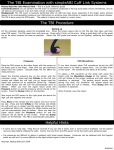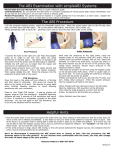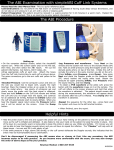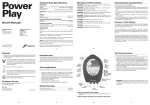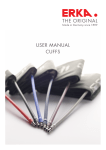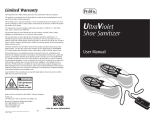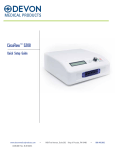Transcript
The TBI Examination with simpleABI Systems Please Read the User Manual first – This is a quick reference guide Contraindications: Do not perform the TBI exam on someone suspected of having acute deep venous thrombosis, and do not take an arm pressure in an arm with a shunt or dialysis graft. Background: The TBI exam is typically performed after an ABI has been done, especially if the larger ankle arteries appear to be incompressible (pressure over 200mmHg) or anytime more information is needed about small vessel disease. The TBI is done using the PPG probe. The patient is supine and rested in a warm room. The TBI Procedure Setting up On the computer desktop, select the simpleABI icon. When the screen opens click on the File tab, then New, and then select TBI report. The TBI report form will come up. Wrap cuffs (12cm) on the arms. Wrap a small digit cuff on the great toe as far down towards the base as possible. Attach the PPG probe and sensor to the DigiDop, replacing the Doppler probe. Pressures PVR Waveforms • Place the PPG sensor on the index finger with the sensor on the fleshy part of the finger. Wait until you get consistent beeps from the system. (Double beats will not affect the measurement.) If you have already taken PVR waveforms during the ABI exam there is no need to repeat them. You can take them in this report. The waveforms are taken at the ankle. • Attach the hose from the pump/PVR box to the arm cuff, inflate until you no longer hear the signal, and continue for an additional 20 mmHg. Slowly bleed pressure down until the signal returns and note that return pressure. This is the systolic pressure. Then rapidly deflate the cuff. Enter the pressure into the brachial field on the report. • Now move the PPG sensor to the right toe above the digit cuff and opposite the toenail. It may help reduce extraneous signals to tape the cord from the sensor to the foot. • Attach the hose to the digit cuff and inflate about 20mmHg past where the pulse beep disappears. Slowly deflate the cuff and note the pressure when the sound returns. Enter this pressure into the TOE pressure box on the screen. The TBI is automatically calculated. • Wrap 10cm cuffs around each ankle above the ankle bone. • Attach the hose from the PVR box to the cuff. Click on the PVR box on the screen. Inflate the cuff to 75mmHg and then deflate to about 65mmHg. The green bar should be about in the center of its box on the screen. Click on Get Waveform and wait five seconds while the system collects data. The waveform will be displayed. You can click again on Get Waveform if you are not satisfied with the waveform. • When finished, save the report. • Move the cuffs and PPG sensor to the left side of the body and repeat these steps. Helpful Hints • A warm toe is a big help. Keep the toe covered if you can with a towel, even a warm towel if available Let the patient rest and relax before inflating the cuffs. Anchor the cord from the PPG sensor to the foot with some adhesive tape. • Toe pressures are difficult to obtain in patients with small vessel disease. Pressures can be obtained with the Doppler probe as well but it is more difficult as the digit arterial signal is hard to locate. Newman Medical 800-267-5549 NM0033-B
